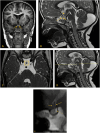Finding its place on the spectrum of pituitary duplication disorders, duplication of pituitary stalk: A case report with brief review of literature
- PMID: 37507120
- PMCID: PMC11138330
- DOI: 10.1177/19714009231193157
Finding its place on the spectrum of pituitary duplication disorders, duplication of pituitary stalk: A case report with brief review of literature
Abstract
Pituitary gland duplication is a rare abnormality and isolated duplication of the pituitary stalk without any pituitary anomaly is an even rarer entity with this case being the first documented case till date. Although incidentally discovered cases of duplication of pituitary gland (DPG) have been reported, sometimes with a duplicated pituitary stalk, patients with this disorder usually present with other craniofacial abnormalities. Consequently, DPG plus syndrome is used as it is often accompanied by endocrine disturbances and pathologies such as median cleft face syndrome, ocular disorders, craniocervical bony abnormalities, vascular anomalies and tuberomammillary masses. Since this is the first reported case without any additional pituitary gland anomaly, we propose the acronym DPS (duplication of pituitary stalk) to be used to unify this entity as we are certain that much like the previously described pituitary duplication disorders, more cases will be documented independently rather than under the umbrella of pituitary duplication disorders. This is critical as the life expectancy (age of diagnosis) in the cases reviewed in our study is as good as normal population with no obvious increase in mortality as compared to existing pituitary duplication syndromes. We present a case report of a 2 year 7 month old girl who was referred by the paediatrician for evaluation of premature thelarche. The duplication of the pituitary stalk along with mega cisterna magna and tuberomammillary fusion was the only positive finding on imaging with the pituitary gland being absolutely normal.
Keywords: DPG plus syndrome; Duplication of pituitary stalk; duplication of pituitary gland; pituitary congenital anomalies.
Conflict of interest statement
Declaration of conflicting interestsThe author(s) declared no potential conflicts of interest with respect to the research, authorship, and/or publication of this article.
Figures

References
-
- Özdemir M, Kavak RP, Şimşir BD, et al. Isolated pituitary stalk duplication.
-
- Slavotinek A, Parisi M, Heike C, et al. Craniofacial defects of blastogenesis: duplication of pituitary with cleft palate and oropharyngeal tumors. Am J Med Genet 2005; 135(1): 13–20. - PubMed
-
- Kandpal H, Seith A, Philip J, et al. Partial duplication of the hypophysis in adult patients: report of 2 cases. J Comput Assist Tomogr 2007; 31(3): 365–367. - PubMed
Publication types
MeSH terms
LinkOut - more resources
Full Text Sources
Medical

